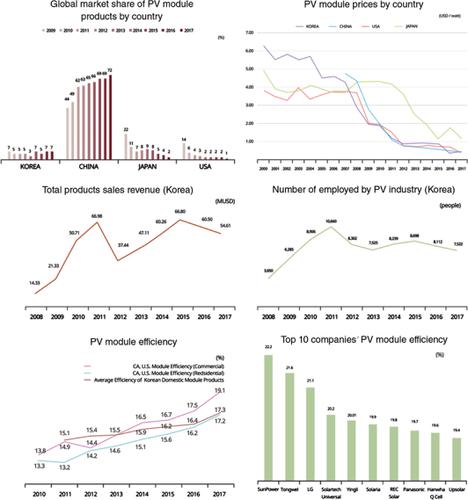当前位置:
X-MOL 学术
›
WIREs Energy Environ.
›
论文详情
Our official English website, www.x-mol.net, welcomes your
feedback! (Note: you will need to create a separate account there.)
Assessing the impact of R&D policy on PV market development: The case of South Korea
Wiley Interdisciplinary Reviews: Energy and Environment ( IF 5.4 ) Pub Date : 2019-11-07 , DOI: 10.1002/wene.366 Yoon‐Hee Ha 1, 2 , John Byrne 2, 3 , Hae‐Seok Lee 1 , Ye‐Jin Lee 1 , Dong‐Hwan Kim 1
Wiley Interdisciplinary Reviews: Energy and Environment ( IF 5.4 ) Pub Date : 2019-11-07 , DOI: 10.1002/wene.366 Yoon‐Hee Ha 1, 2 , John Byrne 2, 3 , Hae‐Seok Lee 1 , Ye‐Jin Lee 1 , Dong‐Hwan Kim 1
Affiliation

|
The purpose of this article is to examine the Korean photovoltaic (PV) R&D strategy and its effectiveness in helping Korean manufacturer competitiveness. The article reviewed the Korean government's PV R&D funding from 2008 to 2017 and investigated the technology readiness levels of 298 R&D projects funded by the Korean government during the same period. It is found that the Korean government followed a two‐track approach of nurturing commercialization technology to cope with rapid growth and volatility in the current global market. The effects of government support for market‐ready and next‐generation technologies in order to position the country in today's competition and to prepare it for “first mover” opportunities in emerging markets are considered. During 2008–2017, Korean manufacturers maintained a 7% of market share. Module prices, which were more than USD 6 per watt in 2000, fell to less than USD 1 in 2017. From a technical point of view, silicon‐based modules have achieved world‐class status in their efficiency. Performance of the country's nonsilicon technologies reached nearly 90% of the world's best nonsilicon products in the early 2010s, but recently, next‐generation technology development is lagging. Despite Korean PV industry's achievements, it is unclear whether Korean government PV R&D strategy affected competitiveness. Since 2013, the Korean government has sharply cut PV R&D funding. Early growth may have been affected by government support, but recent growth may be driven by corporate strategies. A significantly higher level of R&D funding may be needed for Korea's next‐generation technologies to capture “first mover” status.
中文翻译:

评估研发政策对光伏市场发展的影响:以韩国为例
本文的目的是研究韩国光伏(PV)的研发策略及其在提高韩国制造商竞争力方面的有效性。这篇文章回顾了韩国政府从2008年到2017年的PV R&D资金,并调查了同期韩国政府资助的298个R&D项目的技术准备水平。研究发现,韩国政府采取了两种方法来培育商业化技术,以应对当前全球市场的快速增长和动荡。考虑了政府对市场准入和下一代技术的支持所产生的影响,以使该国在当今的竞争中处于领先地位,并为新兴市场中的“先发制人”机会做好准备。在2008-2017年期间,韩国制造商保持了7%的市场份额。组件价格在2000年超过每瓦特6美元,到2017年跌至不足1美元。从技术角度来看,基于硅的组件的效率已达到世界一流水平。在2010年代初,该国非硅技术的性能达到了世界上最好的非硅产品的近90%,但最近,下一代技术的发展却滞后。尽管韩国光伏产业取得了成就,但尚不清楚韩国政府的光伏研发战略是否会影响竞争力。自2013年以来,韩国政府大幅削减了光伏研发资金。早期的增长可能受到政府支持的影响,但近期的增长可能受到公司战略的推动。韩国可能需要更高水平的研发资金
更新日期:2019-11-07
中文翻译:

评估研发政策对光伏市场发展的影响:以韩国为例
本文的目的是研究韩国光伏(PV)的研发策略及其在提高韩国制造商竞争力方面的有效性。这篇文章回顾了韩国政府从2008年到2017年的PV R&D资金,并调查了同期韩国政府资助的298个R&D项目的技术准备水平。研究发现,韩国政府采取了两种方法来培育商业化技术,以应对当前全球市场的快速增长和动荡。考虑了政府对市场准入和下一代技术的支持所产生的影响,以使该国在当今的竞争中处于领先地位,并为新兴市场中的“先发制人”机会做好准备。在2008-2017年期间,韩国制造商保持了7%的市场份额。组件价格在2000年超过每瓦特6美元,到2017年跌至不足1美元。从技术角度来看,基于硅的组件的效率已达到世界一流水平。在2010年代初,该国非硅技术的性能达到了世界上最好的非硅产品的近90%,但最近,下一代技术的发展却滞后。尽管韩国光伏产业取得了成就,但尚不清楚韩国政府的光伏研发战略是否会影响竞争力。自2013年以来,韩国政府大幅削减了光伏研发资金。早期的增长可能受到政府支持的影响,但近期的增长可能受到公司战略的推动。韩国可能需要更高水平的研发资金











































 京公网安备 11010802027423号
京公网安备 11010802027423号